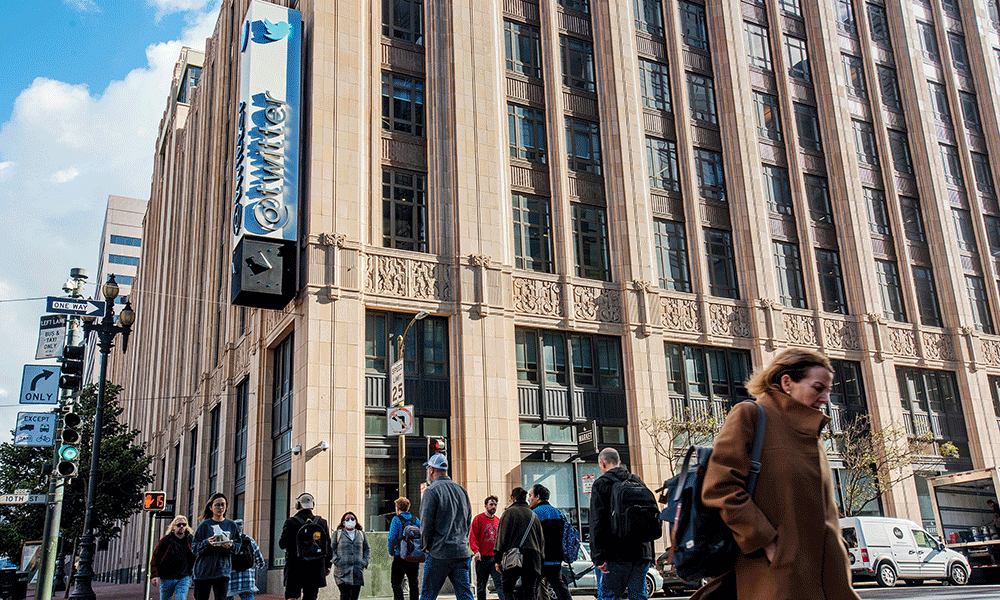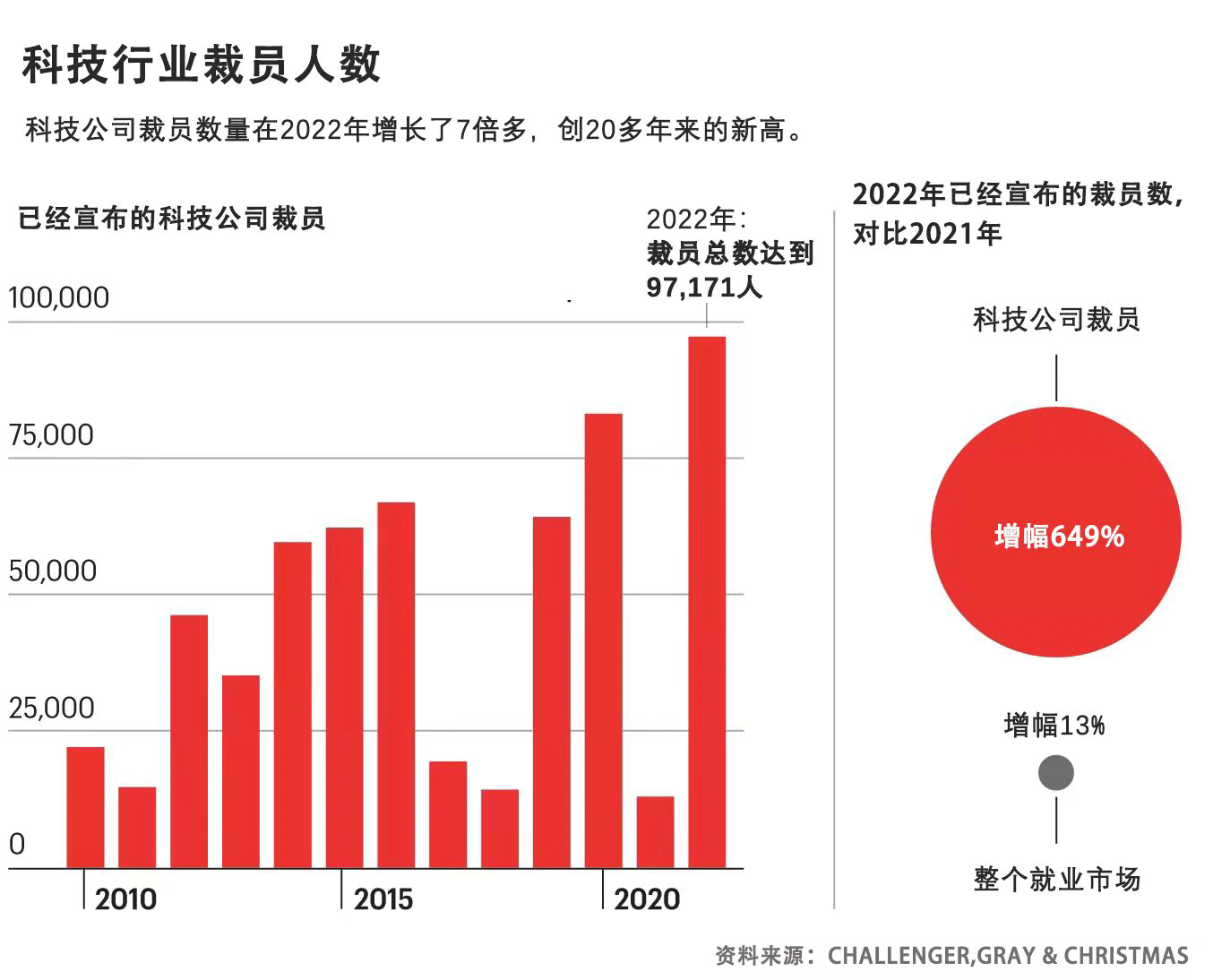大型科技公司的被裁员工成了其他公司的香饽饽

2022年11月4日,一封电子邮件降临,标题写着:你在推特(Twitter)的职责。
这家社交媒体巨头的前产品管理总监格蕾丝-安·贝克说:“这是我第一次被裁。”事实证明,被裁的并非贝克一人。在新东家埃隆·马斯克接手时,这家困难重重的公司拥有7,500名员工,其中近三分之二的员工将成为裁员对象。在接下来的数周和数月中,这一趋势在科技行业持续蔓延,而且范围越来越广。随着经济发展的放缓,这些科技公司如今裁员的速度并不亚于其在新冠疫情期间招聘员工的速度。
亚马逊(Amazon)裁掉了超过1.8万名员工;谷歌(Google)的母公司Alphabet裁员1.2万人;Facebook的母公司Meta裁员1.1万人;微软(Microsoft)裁员1万人。小型公司亦加入了裁员阵营,支付服务提供商Stripe、在线视频托管服务Vimeo和电子零售商Stitch Fix纷纷宣布了瘦身计划。
一夜之间,这些曾几何时备受追捧,尊享丰厚薪资、福利和分红的高科技员工军团,转而变成了求职大军,踏足这个不得不更新其简历并等待招聘者回音的陌生领地。
然而,很多人在寻找新工作方面并没有遇到什么困难,他们发现自己的技能依然属于紧俏商品。有鉴于科技行业如今的颓势,很多科技行业之外的雇主正在争抢失业的软件工程师和网页设计师,而此前,上述其中一些雇主在长达十年的硅谷热期间因为自身古板的形象和较低的薪资,难以招到科技人才。
非科技行业雇主?不妨想想医疗、金融和政府部门。它们的工作更加稳定,而且员工在某些情况下有机会加入耗费数年组建成的大型科技团队。
在沃尔玛(Walmart),超过2万名工程师、UX专家和数据科学家目前在其核心领域工作,从电子商务一直到信息安全岗位。该公司的一位发言人以不折不扣的招聘者语气表示:“这对零售科技来说是一个令人振奋的时刻。”
金融服务巨头摩根大通(JPMorgan Chase)在全球拥有5.5万名技术人员,其高管对于吸引技术人员以及留住现有员工亦非常乐观。摩根大通的全球首席信息官洛里·比尔在发给《财富》杂志的电子邮件里称:“说到趋势,我们将看到越来越多的技术人员会选择留在公司,而我们的人员流失率也将降至新冠疫情前的水平。求职者如今被企业争抢的现象将越来越少。”
现实中,科技与其他行业的裁员数量形成了鲜明对比。职业介绍服务公司Challenger, Gray & Christmas称,2022年,科技公司裁员数量超过了9.7万名,较一年前该行业的裁员数增长了649%。与此同时,各行业雇主的裁员总数达到了近36.4万名,同比仅增长了13%。(如果不计科技行业,整体裁员数量实际上较去年有所下滑。)
事实上,尽管当前经济充满了不确定性,但美国劳工统计局(Bureau of Labor Statistics)的数据显示,美国整体经济仅在2022年12月便新增就业22.3万人。换句话说,就业市场依然十分健康,但科技领域除外。
之所以出现这种迥异的现象,原因有很多。在景气年份,很多科技公司开始大肆招聘,尤其在新冠疫情期间,以满足因为封锁令而苦不堪言的客户和企业的需求激增。
如今,由于新冠的防疫措施基本已经取消了,而且近期的加息使得经济停滞不前,为了削减成本,科技企业的高管们纷纷祭出了裁员大旗。
即便对于此前很难招到技术人才的政府机构而言,此次裁员潮也为其带来了千载难逢的机会。美国退伍军人事务部(Department of Veterans Affairs)的信息与技术副秘书兼首席信息官库尔特·德尔贝内说:“我们将对外宣布机构要招聘人手的消息。”
美国退伍军人事务部当前有700多个技术岗位空缺,包括其云基础构架和网络安全团队。德尔贝内称,他通过领英(LinkedIn)和其他渠道收到的职位咨询数量明显有所增加。他还从自家机构举办的虚拟招聘会上收到了“数百条”线索。
德尔贝内说:“我们是最大的医疗服务提供商,也是美国最大的金融机构。如果你理想的工作是解决超级难题,那么来我们这里就对了。”
诚然,政府工作的薪资在历史上一直都无法与私营领域相比,即便对于技术人才来说也是如此。德尔贝内指出,在华盛顿特区,工程师在美国退伍军人事务部与科技公司之间的薪资差距高达66%。然而,美国退伍军人事务部和其他联邦机构正在敦促政府为特种岗位设立“特殊薪资标准”。到目前为止,这一举措似乎初见成效:今年1月,某些技术岗位的薪资变化得到了批准。德尔贝内表示:“我希望把退伍军人事务部打造为联邦政府中[技术型雇员]的最佳职场。”
还有一种类型的机构也成为了其中一些被裁技术人才的青睐对象,即那些不怎么显山露水的科技公司。它们的规模很大,但十分低调,因此在与知名社交媒体和金融科技公司争抢人才时会很吃力。高管猎头公司Rich Talent Group的创始人及首席执行官贾娜·里奇在谈及税收软件开发商Intuit和Photoshop背后的科技工具Adobe时表示:“我听到Intuit和Adobe这些公司有意招聘大量人才。这些公司经营有方,十分赚钱,增速快,人才留存率也高,但它们也在不断地升级其业务模式。人们在那里能够学到技能,并得到晋升。”
有一个领域似乎并不在被裁大军的考虑之列,那就是处于早期阶段的初创企业。这是合乎情理的:里奇称,如今求职者看重的是公司的财务健康度和生存能力。首先,年轻的初创企业并没有多少可查业绩。其次,如果它很快便需要进行新的融资,能不能生存下来还是两说的事情。有鉴于当前经济的下行趋势,风投资本大幅放缓了对新科技公司的投资。

当然,并非所有人都在争先恐后地寻找新东家,部分原因在于大多数科技公司为被裁雇员提供了相对丰厚的遣散方案。例如,商业软件巨头赛富时(Salesforce)给近期遭裁的8,000名员工发放了5个月的薪资,外加医疗保险。Meta则提供了16周的薪资和福利,外加在Meta每工作一年额外支付两周的工资。
毫无疑问,这些方案缓冲了裁员带来的冲击,而技术人员在不同行业依然十分抢手的事实也起到了类似的作用。不过,成为被裁对象并不是什么有趣的事情,而且一些失业雇员担心,随着经济开始走下坡路,其他行业在未来几个月也会有所收缩。
DoorDash一位不愿透露姓名的前技术雇员表示:“在情绪方面,我已经接受了这个现实。”(这家餐厅送货应用程序在2022年11月宣布裁员1,250名,占其员工总数的6%。)不过,当这一时刻来临,也就是她意识到自己已经无法访问自己的工作账户时:“各种情绪涌上心头。”在被裁数周之后,这位前雇员称还没有想好自己接下来该何去何从。机会是有的,尤其对于那些愿意尝试新事物的雇员:“我跟几名猎头和招聘者进行了沟通,他们异口同声地提到,非传统科技公司如今正在大量招聘技术人才。”
对于推特的前员工贝克来说,有鉴于马斯克接手之后公司出现的各种混乱局面,她对裁员的反应,或者至少她自己体会到的一种情绪,是解脱。这里也会有一种同志之间的友情,因为有如此多的员工都在经历同样的事情。她正在认真考虑自己接下来到底想去哪里工作,而自己已经获得的公司关注度和参加过的面试让其对此十分乐观。曾经在思科(Cisco)和谷歌等巨头工作过的贝克说:“就业机会还是有的,而且我认识的大多数人都找到了工作。”
至于会选择什么样的新工作和新公司,她依然没有做出决定。她说,在推特工作了三年后,有一件事可以确定的是:“我很开明。”
*****
裁员局势
大大小小的科技公司在最近几个月里纷纷开始裁员。以下是其中的一些公司及其裁员数量:
亚马逊
18,000
Meta
11,000
微软
10,000
赛富时
8,000
思科
4,000
推特*
3,700
DoorDash
1,250
Stripe
1,000
Coinbase
950
Carbon Health
200(财富中文网)
*仅包含推特的第一轮裁员人数。
本文另一版本登载于《财富》杂志2023年2/3月刊,标题为《科技公司的岗位大调整》(The great tech-job reshuffle)。
译者:冯丰
审校:夏林
2022年11月4日,一封电子邮件降临,标题写着:你在推特(Twitter)的职责。
这家社交媒体巨头的前产品管理总监格蕾丝-安·贝克说:“这是我第一次被裁。”事实证明,被裁的并非贝克一人。在新东家埃隆·马斯克接手时,这家困难重重的公司拥有7,500名员工,其中近三分之二的员工将成为裁员对象。在接下来的数周和数月中,这一趋势在科技行业持续蔓延,而且范围越来越广。随着经济发展的放缓,这些科技公司如今裁员的速度并不亚于其在新冠疫情期间招聘员工的速度。
亚马逊(Amazon)裁掉了超过1.8万名员工;谷歌(Google)的母公司Alphabet裁员1.2万人;Facebook的母公司Meta裁员1.1万人;微软(Microsoft)裁员1万人。小型公司亦加入了裁员阵营,支付服务提供商Stripe、在线视频托管服务Vimeo和电子零售商Stitch Fix纷纷宣布了瘦身计划。
一夜之间,这些曾几何时备受追捧,尊享丰厚薪资、福利和分红的高科技员工军团,转而变成了求职大军,踏足这个不得不更新其简历并等待招聘者回音的陌生领地。
然而,很多人在寻找新工作方面并没有遇到什么困难,他们发现自己的技能依然属于紧俏商品。有鉴于科技行业如今的颓势,很多科技行业之外的雇主正在争抢失业的软件工程师和网页设计师,而此前,上述其中一些雇主在长达十年的硅谷热期间因为自身古板的形象和较低的薪资,难以招到科技人才。
非科技行业雇主?不妨想想医疗、金融和政府部门。它们的工作更加稳定,而且员工在某些情况下有机会加入耗费数年组建成的大型科技团队。
在沃尔玛(Walmart),超过2万名工程师、UX专家和数据科学家目前在其核心领域工作,从电子商务一直到信息安全岗位。该公司的一位发言人以不折不扣的招聘者语气表示:“这对零售科技来说是一个令人振奋的时刻。”
金融服务巨头摩根大通(JPMorgan Chase)在全球拥有5.5万名技术人员,其高管对于吸引技术人员以及留住现有员工亦非常乐观。摩根大通的全球首席信息官洛里·比尔在发给《财富》杂志的电子邮件里称:“说到趋势,我们将看到越来越多的技术人员会选择留在公司,而我们的人员流失率也将降至新冠疫情前的水平。求职者如今被企业争抢的现象将越来越少。”
现实中,科技与其他行业的裁员数量形成了鲜明对比。职业介绍服务公司Challenger, Gray & Christmas称,2022年,科技公司裁员数量超过了9.7万名,较一年前该行业的裁员数增长了649%。与此同时,各行业雇主的裁员总数达到了近36.4万名,同比仅增长了13%。(如果不计科技行业,整体裁员数量实际上较去年有所下滑。)
事实上,尽管当前经济充满了不确定性,但美国劳工统计局(Bureau of Labor Statistics)的数据显示,美国整体经济仅在2022年12月便新增就业22.3万人。换句话说,就业市场依然十分健康,但科技领域除外。
之所以出现这种迥异的现象,原因有很多。在景气年份,很多科技公司开始大肆招聘,尤其在新冠疫情期间,以满足因为封锁令而苦不堪言的客户和企业的需求激增。
如今,由于新冠的防疫措施基本已经取消了,而且近期的加息使得经济停滞不前,为了削减成本,科技企业的高管们纷纷祭出了裁员大旗。
即便对于此前很难招到技术人才的政府机构而言,此次裁员潮也为其带来了千载难逢的机会。美国退伍军人事务部(Department of Veterans Affairs)的信息与技术副秘书兼首席信息官库尔特·德尔贝内说:“我们将对外宣布机构要招聘人手的消息。”
美国退伍军人事务部当前有700多个技术岗位空缺,包括其云基础构架和网络安全团队。德尔贝内称,他通过领英(LinkedIn)和其他渠道收到的职位咨询数量明显有所增加。他还从自家机构举办的虚拟招聘会上收到了“数百条”线索。
德尔贝内说:“我们是最大的医疗服务提供商,也是美国最大的金融机构。如果你理想的工作是解决超级难题,那么来我们这里就对了。”
诚然,政府工作的薪资在历史上一直都无法与私营领域相比,即便对于技术人才来说也是如此。德尔贝内指出,在华盛顿特区,工程师在美国退伍军人事务部与科技公司之间的薪资差距高达66%。然而,美国退伍军人事务部和其他联邦机构正在敦促政府为特种岗位设立“特殊薪资标准”。到目前为止,这一举措似乎初见成效:今年1月,某些技术岗位的薪资变化得到了批准。德尔贝内表示:“我希望把退伍军人事务部打造为联邦政府中[技术型雇员]的最佳职场。”
还有一种类型的机构也成为了其中一些被裁技术人才的青睐对象,即那些不怎么显山露水的科技公司。它们的规模很大,但十分低调,因此在与知名社交媒体和金融科技公司争抢人才时会很吃力。高管猎头公司Rich Talent Group的创始人及首席执行官贾娜·里奇在谈及税收软件开发商Intuit和Photoshop背后的科技工具Adobe时表示:“我听到Intuit和Adobe这些公司有意招聘大量人才。这些公司经营有方,十分赚钱,增速快,人才留存率也高,但它们也在不断地升级其业务模式。人们在那里能够学到技能,并得到晋升。”
有一个领域似乎并不在被裁大军的考虑之列,那就是处于早期阶段的初创企业。这是合乎情理的:里奇称,如今求职者看重的是公司的财务健康度和生存能力。首先,年轻的初创企业并没有多少可查业绩。其次,如果它很快便需要进行新的融资,能不能生存下来还是两说的事情。有鉴于当前经济的下行趋势,风投资本大幅放缓了对新科技公司的投资。
当然,并非所有人都在争先恐后地寻找新东家,部分原因在于大多数科技公司为被裁雇员提供了相对丰厚的遣散方案。例如,商业软件巨头赛富时(Salesforce)给近期遭裁的8,000名员工发放了5个月的薪资,外加医疗保险。Meta则提供了16周的薪资和福利,外加在Meta每工作一年额外支付两周的工资。
毫无疑问,这些方案缓冲了裁员带来的冲击,而技术人员在不同行业依然十分抢手的事实也起到了类似的作用。不过,成为被裁对象并不是什么有趣的事情,而且一些失业雇员担心,随着经济开始走下坡路,其他行业在未来几个月也会有所收缩。
DoorDash一位不愿透露姓名的前技术雇员表示:“在情绪方面,我已经接受了这个现实。”(这家餐厅送货应用程序在2022年11月宣布裁员1,250名,占其员工总数的6%。)不过,当这一时刻来临,也就是她意识到自己已经无法访问自己的工作账户时:“各种情绪涌上心头。”在被裁数周之后,这位前雇员称还没有想好自己接下来该何去何从。机会是有的,尤其对于那些愿意尝试新事物的雇员:“我跟几名猎头和招聘者进行了沟通,他们异口同声地提到,非传统科技公司如今正在大量招聘技术人才。”
对于推特的前员工贝克来说,有鉴于马斯克接手之后公司出现的各种混乱局面,她对裁员的反应,或者至少她自己体会到的一种情绪,是解脱。这里也会有一种同志之间的友情,因为有如此多的员工都在经历同样的事情。她正在认真考虑自己接下来到底想去哪里工作,而自己已经获得的公司关注度和参加过的面试让其对此十分乐观。曾经在思科(Cisco)和谷歌等巨头工作过的贝克说:“就业机会还是有的,而且我认识的大多数人都找到了工作。”
至于会选择什么样的新工作和新公司,她依然没有做出决定。她说,在推特工作了三年后,有一件事可以确定的是:“我很开明。”
*****
裁员局势
大大小小的科技公司在最近几个月里纷纷开始裁员。以下是其中的一些公司及其裁员数量:
亚马逊
18,000
Meta
11,000
微软
10,000
赛富时
8,000
思科
4,000
推特*
3,700
DoorDash
1,250
Stripe
1,000
Coinbase
950
Carbon Health
200(财富中文网)
*仅包含推特的第一轮裁员人数。
本文另一版本登载于《财富》杂志2023年2/3月刊,标题为《科技公司的岗位大调整》(The great tech-job reshuffle)。
译者:冯丰
审校:夏林
The email landed on Nov. 4. The subject line: Your role at Twitter.
“It was my first time getting laid off,” says Grace-Ann Baker, a former director of product management at the social media company. As it turned out, Baker wasn’t alone. New owner Elon Musk would eventually let go of nearly two-thirds of the 7,500 employees he’d inherited at the beleaguered company. And in the coming weeks and months, the trend continued across the broader technology sector. Just as fast as tech companies had hired employees during the pandemic, they now quickly shed them as the economy slowed.
At Amazon, more than 18,000 people were laid off; at Google parent Alphabet, 12,000; at Facebook parent Meta, 11,000; and at Microsoft, 10,000. Smaller companies downsized too, with layoffs announced at payments provider Stripe, online video hosting service Vimeo, and e-tailer Stitch Fix.
All of a sudden, legions of tech workers—once in demand and showered with big salaries and generous perks and bonuses—found themselves looking for jobs, in the unfamiliar position of having to update their résumés and wait for callbacks from recruiters.
But instead of struggling to find new work, many are discovering that their skills are still a hot commodity. Many employers outside tech, some of which had trouble attracting tech talent during Silicon Valley’s decade-long boom because of their stodgy reputations and lower pay, are scooping up unemployed software engineers and web designers now that the tech industry is in retreat.
Those non-tech employers? Think sectors like health care, finance, and government. They offer more stability and, in some cases, the opportunity to join huge tech teams built up over the years.
At Walmart, more than 20,000 engineers, UX specialists, and data scientists currently work in core areas, from e-commerce to information security. “It’s an exciting time for retail tech,” says a company spokesperson in unabashed recruiter mode.
At financial services giant JPMorgan Chase, which already employs 55,000 technologists globally, executives are also upbeat about attracting tech workers—and about retaining the ones they have. “In terms of trends, we are seeing more technologists staying put, with attrition decreasing to pre-pandemic levels,” Lori Beer, JPMorgan’s global chief information officer, tells Fortune via email. “Candidates today have fewer competing offers.”
The contrasting realities between tech and other industries is encapsulated in the layoff numbers. In 2022, tech companies laid off more than 97,000 employees, representing a 649% increase from cuts in the sector the year before, according to outplacement services firm Challenger, Gray & Christmas. Meanwhile, employers across all industries combined cut nearly 364,000 jobs, representing just a 13% increase in overall cuts from the year before. (If tech is excluded, overall layoffs actually declined from the previous year.)
In fact, despite the current economic uncertainty, the overall U.S. economy managed to add 223,000 jobs in December alone, according to the Bureau of Labor Statistics. In other words, the job market is still healthy—just not in the tech sector.
The reasons for the divergent trajectories are many. During the boom years, many tech companies went on hiring sprees, particularly during the pandemic in order to meet a spike in demand from consumers and businesses mired in lockdowns.
Now, with pandemic precautions largely abandoned, and the economy sputtering because of recent interest rate hikes, tech executives are cutting costs by eliminating jobs.
Even on the government side, which previously had trouble luring techies, the layoffs present a rare opportunity. “We’re getting the word out that we’re looking for people,” says Kurt DelBene, assistant secretary for information and technology and CIO of the Department of Veterans Affairs.
The VA currently has more than 700 job openings for tech workers, including on its cloud infrastructure and cybersecurity teams. And according to DelBene, there is a noticeable increase in the number of inbound inquiries he’s receiving through LinkedIn and elsewhere. He’s also received “hundreds” of leads from recent virtual job fairs the VA has hosted.
“We are the largest health care provider and the largest financial institution in the U.S.,” says DelBene. “You want to go to a place where there are really, really hard problems to solve? That’s the organization we’re running.”
To be sure, government jobs haven’t historically paid as well as the private sector—even when it comes to tech talent. DelBene says that in the Washington, D.C., area, the gap between what an engineer could earn at the VA versus at a tech company is as high as 66%. But the VA and other federal agencies have been pushing the government to allow a “special salary rate” for specific job functions, and so far, it appears to be working: In January, the change was approved for certain tech positions. “I want to make this the best place [for tech employees] to work in the federal government,” says DelBene.
There’s another type of organization that’s attracting some of the laid-off tech talent: tech companies that don’t often make headlines. They’re big, but their lower profiles can make it more difficult to compete for talent against buzzier names in social media and fintech. “I’m hearing a lot of interest in places like Intuit and Adobe,” says Jana Rich, founder and CEO of Rich Talent Group, an executive recruiting firm, referring to the tax-software maker and the company behind tech tools like Photoshop. “These are very well-run companies, profitable, with growth and high retention rates, but they are also continuously evolving their business models. You are going to gain skills and be promoted there.”
One area that doesn’t appear to be generating as much interest from the laid-off crowd? Early-stage startups. It makes sense: According to Rich, candidates today are interested in the financial health and viability of a company. A young startup doesn’t have much of a track record, to begin with. But it also may not have a future, if it needs a fresh round of funding anytime soon. Because of the economic downturn, venture capital has slowed considerably for new tech companies.
Of course, not everyone is rushing to land a new gig, owing partly to the relatively cushy severance packages most tech companies give laid-off employees. At business software giant Salesforce, for example, the 8,000 workers who were cut recently have been promised five months of pay, plus health insurance. Meta is offering 16 weeks of pay and benefits, and an additional two weeks for every year worked at the company.
The packages soften the blow of layoffs, for sure, as does the fact that techies are still in high demand across different sectors. But getting laid off is no fun, and some out-of-work employees are worried that, with the economy souring, other industries will pull back as well in the coming months.
“Emotionally, I was bracing myself for it,” says one former DoorDash tech employee who did not want to be mentioned by name. (The restaurant delivery app announced layoffs of 1,250 employees in November, representing about 6% of its workforce.) But when the moment came, and she realized she was locked out of her work accounts: “There is a slew of emotions that you feel.” Several weeks after the layoffs, the former employee says she is still taking her time to decide on her next steps. And opportunities exist, especially for techies who are willing to try something new: “I’ve spoken with a few headhunters and recruiters, and they are saying the same thing—that nontraditional tech companies are bullish on tech talent right now.”
As for Baker, formerly of Twitter, her reaction to being laid off, or at least one of the emotions she felt, was relief, given all the tumult at the company amid Musk’s takeover. There was a sense of camaraderie as well, considering that so many people were going through a similar experience. She’s taking time to figure out where she wants to work, but is optimistic given the interest—and interviews—she’s already getting. “There is hiring out there, and most people I know are finding jobs,” says Baker, whose CV includes tech giants like Cisco and Google.
As for what her next role, and company, will be? That’s still TBD. After three years at Twitter, she says, one thing is for sure: “I’m open-minded.”
*****
Land of layoffs
Tech companies big and small have been laying off employees in recent months. Here are some of them and the number of jobs they have cut:
Amazon
18,000
Meta
11,000
Microsoft
10,000
Salesforce
8,000
Cisco
4,000
Twitter*
3,700
DoorDash
1,250
Stripe
1,000
Coinbase
950
Carbon Health
200
*Only the first round of Twitter’s layoffs is included.
This article appears in the February/March 2023 issue of Fortune with the headline, “The great tech-job reshuffle.”













